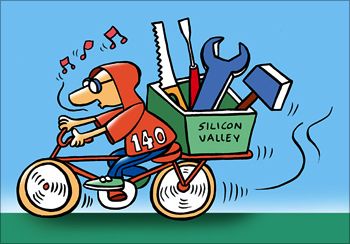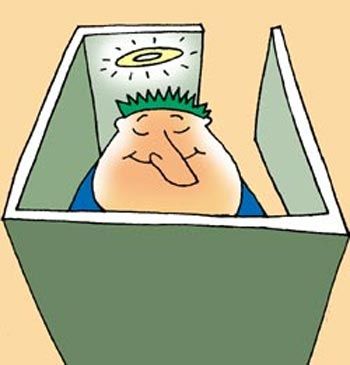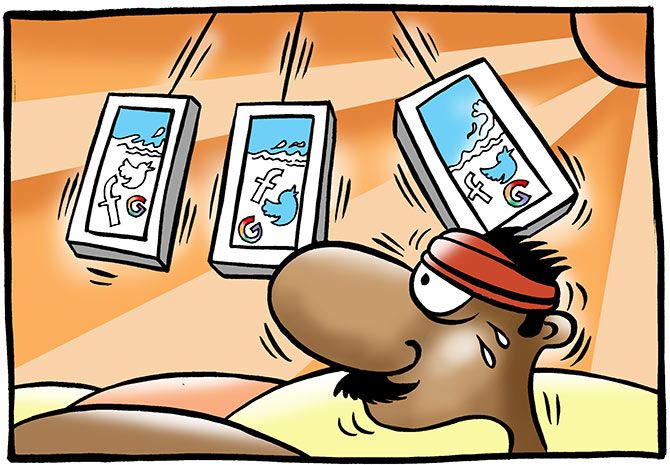'They don't always agree with our governments, their teachers or their parents, but it is the conviction of their ideas, and their determination to share them with the world that, I believe, is one of the greatest sources of hope for our planet.'
'The colonisation of space, understanding the very building blocks of matter and the universe, utilising our understanding of the human genome to conquer disease -- these are the tasks waiting for a fellowship of minds to realise new triumphs in our collective destiny.'
US Ambassador Richard Rahul Verma maps out the enormous possibilities for an Indian and US Fellowship of Minds.
 I'd like to talk to you today about what I believe is the greatest promise in the coming together of the people of the United States and India -- our young thinkers.
I'd like to talk to you today about what I believe is the greatest promise in the coming together of the people of the United States and India -- our young thinkers.
As I have traveled around this great country and met with scientists, entrepreneurs, scholars and students I have marveled at the energy and brilliance of the minds I have encountered, and have been continually amazed at the creativity and commitment to service among the young Indians I have met.
Whether devising technological innovations to serve the needs of their communities or making their voices heard about international issues, India is regarded around the world as home to some of the most groundbreaking young minds on the planet.
I've also been enormously pleased to see the irrepressible enthusiasm of young Americans and Indians as they seek each other out to discuss -- on Facebook, Skype and Twitter -- the issues about which they are passionate.
They don't always agree with our governments, their teachers or their parents, but it is the conviction of their ideas, and their determination to share them with the world that, I believe, is one of the greatest sources of hope for our planet.
It's fitting that I'm speaking about innovation today in Bangalore, a city that has long been at the forefront of scientific discovery in India.
In 1905, Bangalore became the first city in Asia with electrical power and I am gratified to know that the United States and India have been working together on clean energy since the turn of the last century when General Electric helped to install Asia's first hydroelectric power station here, in Shivanasamudra, which is still producing carbon-neutral energy today.
Although it may be a bit unorthodox, I'd like to begin my remarks to you today with a few lines from the American poet Ralph Waldo Emerson who, in 1833, wrote the following verse:
Oh what is Heaven but the fellowship
Of minds that each can stand against the world
By its own meek and incorruptible will?
A fellowship of minds. Which two countries better embody this ideal than the world's oldest and largest democracies?
Two dynamic countries founded on a commitment to liberty of thought and speech.
Two countries whose young citizens, thanks to the freedoms they enjoy, are charged with intellectual bravery and rigor.
And two countries whose very different histories and traditions gave rise to differing perspectives on the world that are equally vital and mutually essential.
I have spoken before about the relationship between our two countries as an alliance for global prosperity, but I ask you to imagine the possibilities if this alliance were to unleash the combined creativity of our young thinkers for the good of humankind.
A few weeks ago Prime Minister Modi's words seemed to echo those of Emerson when he said, after meeting President Obama in New York, that the great promise of the US-India relationship lies in 'youth, technology and innovation -- and the natural partnership of Indians and Americans in advancing human progress.'
 The history of discovery is built upon the bravery of those women and men who raised a question, launched an idea or suggested a new way of looking at a problem that changed the world.
The history of discovery is built upon the bravery of those women and men who raised a question, launched an idea or suggested a new way of looking at a problem that changed the world.
But the most revolutionary thinkers were those who embraced the fellowship of minds described by Emerson, and viewed their innovations as pieces of a puzzle that could only be completed by others.
Intellectual collaboration, propelled by an openness of mind and esteem for diversity, has the power to change the very firmament of our planet.
In 1956 the English meteorologist G M B Dobson first recorded an anomaly in the ozone layer over the Antarctic. At that time few members of the scientific community perceived implications of this phenomenon.
Over subsequent decades hundreds of scientists from dozens of countries working under the UN Environment Programme and the World Meteorological Organisation gradually came to the understanding that human actions were shredding the protective layers of our atmosphere that made human life possible on earth.
They realised that human use of chlorofluorocarbons and hydrofluorocarbons, or CFCs and HFCs, were resulting in the depletion of ozone in the earth's stratosphere with grave consequences to human health and agriculture.
Thinkers from countries as diverse as Ecuador and Sweden -- and including Dr Gufran Beig of the Indian Institute of Tropical Meteorology -- did something that was, quite literally, earth-changing. Through the sheer power of ideas, they persuaded the governments of the world to put in place, and continually strengthen, a mechanism that is actually reversing this process.
The Montreal Protocol, established in 1987 as a result of international scientific collaboration, has resulted in the world-wide end of CFC production and has begun the healing of our planet's ozone layer preventing millions of cases of cancer and threats to global food security.
At about the same time that Dr Dobson was analysing data on the Antarctic anomalies, a young Indian post-doctoral student research associate was arriving at the University of Wisconsin. Dr M S Swaminathan, motivated by a deep personal commitment to ensuring that no human being on the planet should ever face the horror of famine, began his collaboration with the famous American researcher, Dr Norman Borlaug.
During several years of collaborative research in America, Dr Swaminathan developed the ideas that would lead to his scientific breakthroughs in high yield rice and wheat. That collaboration between two young Indian and American scientists helped change the course of human history by liberating millions of people around the world from the seasonal fear of crop failure and famine.
Collaboration between Indian and American minds continues to save and change lives today. The US Centres for Disease Control and the National Institute for Mental Health and Neuro Sciences here in Bangalore are right now engaged in joint research to more effectively diagnose, test, and treat acute encephalitis syndrome, which causes thousands of illnesses and hundreds of deaths every year around the world.
Also here in Bangalore, the CDC is working with India's National Institute of Veterinary Epidemiology and Disease Informatics to detect, control and prevent diseases that can be transmitted from animals to humans, which cause 60% of all human illness.
Disease knows no borders and the advances that our scientist make together will prevent untold suffering for people around the world.
Engineers in Bangalore and in Silicon Valley have collaborated to create a portable ventilator allowing hospitals and clinics in rural areas to provide lifesaving care. Design engineers from Silicon Valley have also collaborated with the famous 'Jaipur Foot' organisation to develop an improved artificial knee for amputees. This simple device has allowed young men and women who have not walked for years them to reclaim their mobility and dignity.
Back in 2009, before innovation and startups became the buzzwords that they are today, our governments established the US-India Science and Technology Endowment Fund. Seeded with a 640 million rupee endowment at the US embassy, the fund partners with India's Department of Science and Technology to issue yearly calls for proposals for up to 2.5 crore (25 million) rupees each.
To date we have funded 18 proposals including technologies to remove toxic arsenic from groundwater in Bengal and Bihar, a solar electric tractor; a low-cost portable auto-refractor to prescribe corrective eyeglasses in areas without eye doctors; a device to resuscitate newborn babies who can't breathe; seed treatments to improve stress tolerance in crops; and many more ideas are in the pipeline.
 This is just the beginning. During the recently concluded Strategic and Commercial Dialogue in Washington, DC, our governments agreed that in 2016 we would launch a private sector-led Innovation Forum to ignite and scale innovation and encourage entrepreneurship.
This is just the beginning. During the recently concluded Strategic and Commercial Dialogue in Washington, DC, our governments agreed that in 2016 we would launch a private sector-led Innovation Forum to ignite and scale innovation and encourage entrepreneurship.
The United States has also been a strong supporter of the prime minister's 'Start Up India, Stand Up India' initiative to encourage entrepreneurship among India's youth, and facilitate start-ups across India.
Some have claimed that the different historical and cultural backgrounds of our countries impose limits on the depth of our intellectual collaboration. According to these arguments, the way Indians and Americans see the world is just too different for us to tackle fundamental problems together.
Not only do I reject this view, but I have seen many examples of how our differences strengthen, rather than detract from our ability to forge new ideas together.
For example, Indian traditional medicine is generating immense interest in the United States. Officials from the US Department of Health and Human Services recently met in the US with the Indian traditional medicine, or AYUSH, ministry to learn more about this tradition and to discuss the processes under which traditional Indian medicine could become more widely available in the United States. I have been moved by the generosity and enthusiasm with which Indians are eager to share their cultural heritage with the people of my country.
Rather than dismissing Indian traditions as incompatible with Western medicine, American scientists and pharmaceutical companies are working with Indian partners on 'bioprospecting' -- examining traditional medicine as a source of new drug discovery.
About 40% of mainstream pharmaceuticals were derived from plant-based traditional medicines -- drugs like aspirin, morphine, the cancer drug taxol, and the anti-malaria drug artemisinin.
Given the great promise of this collaboration our governments are discussing ways to partner Indian traditional medicine and US expertise in research and drug development to improve the health of people of our countries, and the world.
A discussion about US and Indian innovation in Bangalore would be incomplete without mentioning a few of the many visionaries from this part of India, who have brought our peoples closer together creating thousands of Indian and American jobs in the process.
Luminaries such as N R Narayanamurthy of Bangalore who was just 35 when he established Infosys in 1981 which opened its first international office in Boston in 1987.
Sabeer Bhatia, who grew up in Bangalore and Pune and attended Caltech and Stanford, and founded Hotmail in 1996.
Gururaj 'Desh' Deshpande, the Indian-American venture capitalist and entrepreneur from Hubli, Karnataka, who founded the Massachusetts firm Sycamore Networks and in 2010 was appointed by President Obama as Co-Chairman of the National Advisory Council on Innovation and Entrepreneurship.
And Kumar Malavalli of Mysore, the first Indian member of the Silicon Valley Engineering Hall of Fame.
And I'd like to express my profound personal admiration for IIM-Bangalore Chairman Kiram Mazumdar-Shaw for her pioneering work in biopharmaceuticals and commitment to finding innovative pathways for providing essential services to disadvantaged communities.
A new generation of Indian minds, advancing courageous new ideas, is following in their footsteps. While in Bangalore this year, Prime Minister Modi visited a group of middle school girls who formed one of two teams from India selected to attend the Technovation global technology entrepreneurship forum for girls in San Francisco.
The girls, (Anupama, Navyasree, Sanjana, Mahima, and Swasthi) took home the top prize in the middle school division, and a $10,000 seed funding prize, for an app that created online marketplace to solve waste management challenges.
 During the prime minister's visit to San Jose, he met hundreds of Indian-American entrepreneurs who have helped shape Silicon Valley into the leading engine of innovation in the world.
During the prime minister's visit to San Jose, he met hundreds of Indian-American entrepreneurs who have helped shape Silicon Valley into the leading engine of innovation in the world.
I heard from dozens of these entrepreneurs during a meeting at a tech start-up incubator, who were able to leverage their ties back home in India, and their unique experiences as immigrants, to create successful business ventures in the United States.
And American entrepreneurs are also looking to create opportunities in India. During the prime minister's visit the Qualcomm Venture fund announced it would set aside $150 million to invest in Indian startups.
In the opening decades of the 21st century we stand at an inflection point in human history, a juncture of great opportunities but also one of great peril. Many of the tools that allowed for global industrialisation in the last century -- such as antibiotics, fossil fuels, pesticides -- are now threatening the very habitability of our planet.
Unless we resolve to bring to bear the full creativity of the human spirit to address these challenges the advances we have made over recent generations may be in jeopardy.
At the same time the work of pioneers that have gone before us have provided the first tentative steps towards marvelous new chapters in human history. The colonisation of space, understanding the very building blocks of matter and the universe, utilising our understanding of the human genome to conquer disease -- these are the tasks waiting for a fellowship of minds to realise new triumphs in our collective destiny.
Innovation is nowhere more critical than in the effort to find an effective, long-term global response to our shared climate challenge; and supplying affordable and reliable energy for everyone.
The United States and India could together make no greater gift to humanity than propelling a clean energy revolution that delivers critical economic and environmental benefits to the people of India, the United States and the world.
We are at a critical stage in this effort, global investment by governments and the private sector in clean energy research and development is not keeping pace with the demands of this challenge.
We owe it to future generations to increase the pace of innovation. Governments must scale up public research and development, private companies will need to develop new investment strategies and the financial sector will need to explore new approaches to risk.
President Obama and Prime Minister Modi discussed this question during their September meeting in New York and what the prime minister called 'a global public partnership for developing affordable clean-energy sources.'
We hope that current discussions between the US and Indian governments on increasing government research can begin to channel cutting-edge ideas to the private sector.
The world's greatest philanthropists have also joined this effort, including Bill Gates who has pledged to spend at least $1 billion over the next five years to help governments partner with the private sector to adopt and deploy promising new innovations.
But the efforts of governments and companies can only lay the groundwork for the search. It will take that spark of epiphany joining two intellects, perhaps between two people in this room, perhaps between students in Bangalore and Albuquerque, to give shape to the solutions of tomorrow.
There is a concept in physics called critical mass, which is the minimum amount of contact needed to sustain a chain reaction. We cannot expect our young people to develop the synergies and habits of collaboration on a large scale without bringing our educational systems closer together.
Once these ties are established the inherent talent of our youth will propel discovery on its own, but we are not there yet and this is an urgent task for our governments.
 We are extremely pleased that the number of Indian students applying to study in the United States this year has increased by nearly forty percent over the past year to 130,000. But it is vital that for collaboration to reach its full potential that the exchanges go both ways and that many more American students also study in India.
We are extremely pleased that the number of Indian students applying to study in the United States this year has increased by nearly forty percent over the past year to 130,000. But it is vital that for collaboration to reach its full potential that the exchanges go both ways and that many more American students also study in India.
At the moment far too few American students encounter the rich traditions of Indian scholarship and the ingenuity of its society. To that end we hope to greatly expand collaboration between American and Indian educational institutions. And not just our top tier universities.
The next Infosys or Apple is just as likely to be founded by a graduate of a community college or vocational institute as by an alumnus of a world famous university.
I can think of no two civilisations better suited to rise to the challenges I have described than the United States and India. At the time when pioneers like Dr Swaminathan made their discoveries, intellectual collaboration required long journeys by plane and exchanging scientific papers by registered mail.
Today, thanks to the resolve of our governments to protect free expression and an open internet, emerging thought leaders in our countries can exchange ideas through the tap of a touchscreen -- in an autorickshaw or an Uber, from a Starbucks or a Wow!Momo.
Imagine the vast promise of our young people collaborating, in real time, between Pune and Houston, Srinagar and Miami. The possibilities are limitless.
I'd like to conclude my remarks in the same unorthodox way I started, by reading from a poem that has a very special place in American history.
The great poet Maya Angelou read the following lines at the inauguration of President Clinton in 1993. Her words exhorted the people of America, and all countries, to attain our human potential in the service of a troubled world.
Today, I can think of no more fitting call to the young people of our two countries:
A Rock, A River, A Tree
Hosts to species long since departed,
Marked the mastodon,
The dinosaur, who left dried tokens
Of their sojourn here
On our planet floor,
Any broad alarm of their hastening doom
Is lost in the gloom of dust and ages.
But today, the Rock cries out to us, clearly, forcefully,
Come, you may stand upon my
Back and face your distant destiny,
But seek no haven in my shadow,
I will give you no hiding place down here.
The Rock cries out to us today,
You may stand upon me,
But do not hide your face.
US Ambassador to India Richard Rahul Verma delivered this speech, 'The US and India: A Fellowship of Minds in Service to Humanity', at the Indian Institute of Management-Bangalore.










